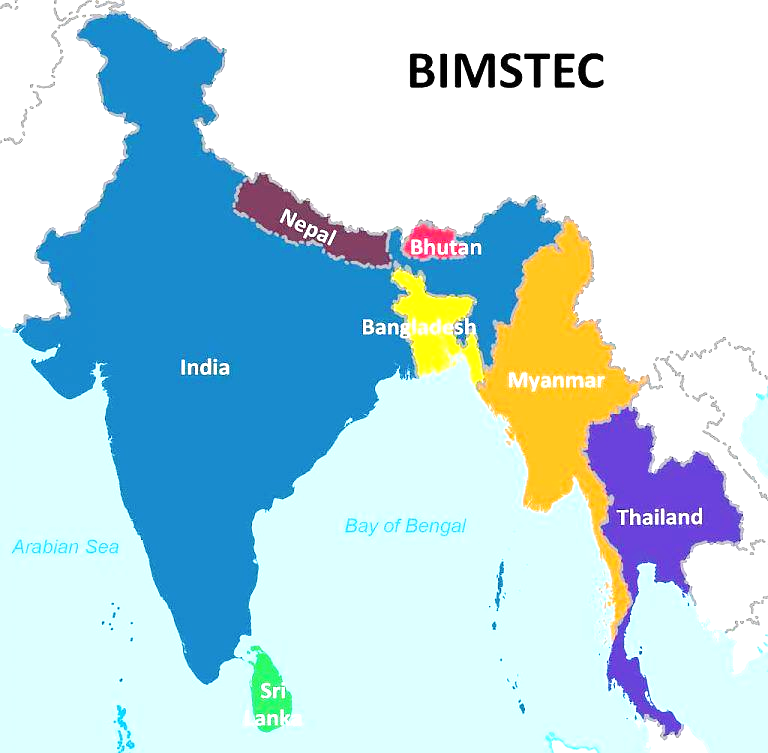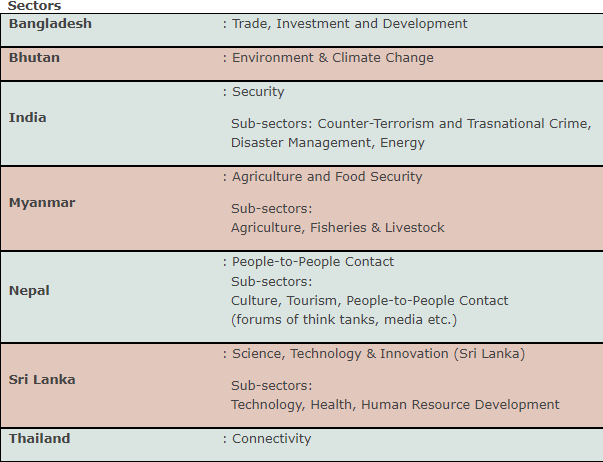International Relations
Fifth BIMSTEC Summit
- 31 Mar 2022
- 6 min read
For Prelims: Fifth BIMSTEC Summit, BIMSTEC, SAARC, BIMSTEC Charter, Indian Ocean Rim Association (IORA).
For Mains: Neighbourhood first policy. Gujral Doctrine, Groupings & Agreements Involving India and/or Affecting India's Interests, Global Groupings
Why in News?
Recently, the Bay of Bengal Initiative for Multi-Sectoral Technical and Economic Cooperation (BIMSTEC) grouping’s fifth summit took place in Colombo, Sri Lanka (Host for the Fifth Summit).
What are the Key Highlights of the Summit?
- BIMSTEC Charter: The signing of the BIMSTEC Charter was the main outcome of this summit.
- Under this Charter, the members were expected to meet once every two years.
- With the Charter, the BIMSTEC now has an international personality. It has an emblem, it has a flag.

- It has a formally listed purpose and principles that it is going to adhere to.
- In line with the development of the organisation into a formal structure, the leaders of the member-countries have agreed to divide the working of the grouping into seven segments, with India providing leadership to the security pillar.
Pillars of BIMSTEC
- Master Plan for Transport Connectivity: The summit saw the declaration of the Master Plan for Transport Connectivity that would provide a framework for regional and domestic connectivity.
- Other Agreements: Member countries also signed a treaty on mutual legal assistance on criminal matters.
- A Memorandum of Association (MoA) on the establishment of BIMSTEC Technology Transfer Facility (TTF) in Colombo, Sri Lanka.
- India will provide the (BIMSTEC) secretariat USD 1 million US dollars to increase its operational budget.
What is BIMSTEC?
- The Bay of Bengal Initiative for Multi-Sectoral Technical and Economic Cooperation (BIMSTEC) is a regional organisation comprising seven Member States: five deriving from South Asia, including Bangladesh, Bhutan, India, Nepal, Sri Lanka and two from Southeast Asia, including Myanmar and Thailand.
- This sub-regional organisation came into being on 6 June 1997 through the Bangkok Declaration.
- With 21.7% of the world’s population and a combined Gross Domestic Product (GDP) of USD 3.8 trillion, BIMSTEC has emerged as an influential engine of economic growth.
- The BIMSTEC Secretariat is in Dhaka.
- Institutional Mechanisms:
- BIMSTEC Summit
- Ministerial Meeting
- Senior Officials’ Meeting
- BIMSTEC Working Group
- Business Forum & Economic Forum
Is BIMSTEC an Alternate of SAARC?
- The PM of India had invited South Asian Association for Regional Cooperation (SAARC) countries for his swearing in ceremony in 2014, including Pakistan on the lines of his Neighbourhood first policy.
- The Prime Minister had also participated in the 18th SAARC summit at Kathmandu in November 2014.
- However, post Uri attack (on an Indian military base) in October 2016, India gave a renewed push for the BIMSTEC that had existed for almost two decades but been largely ignored.
- Alongside the BRICS summit in Goa, PM hosted an outreach summit with BIMSTEC leaders.
- BIMSTEC countries had supported India’s call for a boycott of the SAARC summit scheduled in Islamabad in November 2016.
- As a result, the SAARC summit was postponed for an indefinite period.
- Thus, with work on several key initiatives under SAARC stymied because of the breakdown of the relationship with Pakistan, India began focusing on other regional groupings such as BIMSTEC and Indian Ocean Rim Association (IORA).
Way Forward
- BIMSTEC Free Trade Agreement: There is a need for finalisation of the BIMSTEC Free Trade Agreement among the member countries.
- As the region is facing challenges of health and economic security and stressed the need for solidarity and cooperation, the FTA will make the Bay of Bengal a bridge of connectivity, a bridge of prosperity, a bridge of security.
- Apart from this, there is a necessity for coastal shipping ecosystem and electricity grid interconnectivity, as two of the necessary components of the evolving shape of BIMSTEC.
- Gujral Doctrine: India would have to counter the impression that BIMSTEC is an India-dominated bloc, in that context India can follow the Gujral doctrine that intends to chalk out the effect of transactional motive in bilateral relations.
- The Gujral Doctrine is a set of five principles to guide the conduct of foreign relations with India’s immediate neighbours.These principles are:
- With neighbours like Bangladesh, Bhutan, Maldives, Nepal and Sri Lanka, India does not ask for reciprocity but gives and accommodates what it can in good faith and trust.
- No South Asian country should allow its territory to be used against the interest of another country of the region.
- No country should interfere in the internal affairs of another.
- All South Asian countries must respect each other’s territorial integrity and sovereignty.
- They should settle all their disputes through peaceful bilateral negotiations.
- The Gujral Doctrine is a set of five principles to guide the conduct of foreign relations with India’s immediate neighbours.These principles are:






